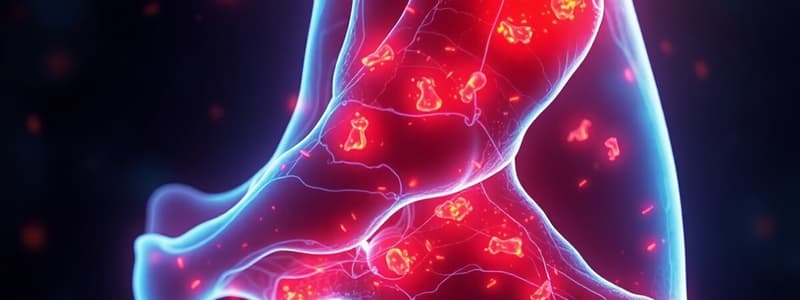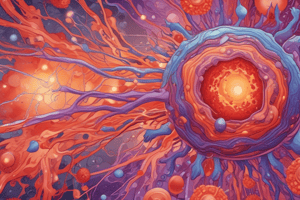Podcast
Questions and Answers
What primarily triggers inflammation in gout?
What primarily triggers inflammation in gout?
- Autoimmune responses
- Infections in the joints
- Increased uric acid production
- Precipitation of monosodium urate crystals (correct)
Which cytokine is notably produced due to the activation of caspase-1 in gout?
Which cytokine is notably produced due to the activation of caspase-1 in gout?
- IL-6
- TNF-α
- IL-10
- IL-1β (correct)
What characterizes acute gout attacks?
What characterizes acute gout attacks?
- Gradual onset over days
- Symmetrical joint pain
- Monoarticular involvement in 90% of cases (correct)
- Chronic inflammation without symptoms
What is a hallmark feature of chronic tophaceous arthritis in gout?
What is a hallmark feature of chronic tophaceous arthritis in gout?
What type of complications can gout lead to involving the kidneys?
What type of complications can gout lead to involving the kidneys?
Which risk factor is NOT associated with the development of gout?
Which risk factor is NOT associated with the development of gout?
Which condition is characterized by inflammatory infiltration in the synovium and synovial fluid in gout?
Which condition is characterized by inflammatory infiltration in the synovium and synovial fluid in gout?
What is the necessary condition for the development of gout regarding hyperuricemia?
What is the necessary condition for the development of gout regarding hyperuricemia?
What is the typical time for acute gout attack symptoms to subside?
What is the typical time for acute gout attack symptoms to subside?
What pathological change occurs in the synovium during chronic tophaceous arthritis?
What pathological change occurs in the synovium during chronic tophaceous arthritis?
What is the role of the inflammasome in gout?
What is the role of the inflammasome in gout?
Chronic tophaceous arthritis is characterized by which of the following features?
Chronic tophaceous arthritis is characterized by which of the following features?
Which of the following best describes tophi in gout?
Which of the following best describes tophi in gout?
What is a common initial symptom of acute gout?
What is a common initial symptom of acute gout?
Which condition is described by having a neutrophilic infiltrate in the synovium?
Which condition is described by having a neutrophilic infiltrate in the synovium?
Which of the following factors significantly contributes to the risk of developing gout?
Which of the following factors significantly contributes to the risk of developing gout?
What pathological change occurs due to repeated attacks of urate crystal precipitation?
What pathological change occurs due to repeated attacks of urate crystal precipitation?
Hyperuricemia is defined as what level of plasma urate?
Hyperuricemia is defined as what level of plasma urate?
What happens to the synovium during the acute attack of gout?
What happens to the synovium during the acute attack of gout?
What is the role of macrophages in gout-related inflammation?
What is the role of macrophages in gout-related inflammation?
What characterizes the progression from acute gout to chronic tophaceous arthritis?
What characterizes the progression from acute gout to chronic tophaceous arthritis?
Which of the following best describes the synovial changes observed in chronic gout?
Which of the following best describes the synovial changes observed in chronic gout?
What might lead to severe joint damage and functional loss in chronic gout?
What might lead to severe joint damage and functional loss in chronic gout?
What combination of symptoms typically indicates an acute gout attack?
What combination of symptoms typically indicates an acute gout attack?
Which of the following factors can contribute to the development of hyperuricemia?
Which of the following factors can contribute to the development of hyperuricemia?
What is a common location for tophi to form in gout?
What is a common location for tophi to form in gout?
What condition could arise as a renal complication of gout?
What condition could arise as a renal complication of gout?
What triggers the production of IL-1β in gout?
What triggers the production of IL-1β in gout?
How long does an acute gout attack typically last if untreated?
How long does an acute gout attack typically last if untreated?
Flashcards are hidden until you start studying
Study Notes
Inflammation and Gout
- Gout inflammation triggered by monosodium urate (MSU) crystal precipitation in joints.
- Cytokines produced attract leukocytes, leading to further inflammation.
- Macrophages participate by phagocytosing MSU; the inflammasome recognizes and activates MSU particles.
- Caspase-1 is activated by the inflammasome, producing proinflammatory cytokine IL-1β, which draws neutrophils and macrophages to joints.
Acute Arthritis
- Characterized by neutrophilic infiltrate in synovium and synovial fluid.
- MSU crystals may be found within neutrophils’ cytoplasm.
- Synovium appears edematous and contains various inflammatory cells, including lymphocytes and plasma cells.
- Symptoms subside when MSU crystals dissolve, concluding the acute episode.
Chronic Tophaceous Arthritis
- Develops from repeated MSU crystal precipitation during acute attacks.
- MSU deposits crust articular surfaces and invade synovium.
- Synovial tissue becomes hyperplastic, fibrotic, and thickened due to inflammatory response.
- Pannus formation and damage to cartilage, causing juxta-articular bone erosions.
- Severe cases can lead to fibrous and bony ankylosis, significantly affecting joint function.
Tophi
- Tophi are characteristic of gout; aggregates of urate crystals encased in foreign body giant cell inflammatory reaction.
- Commonly found in articular cartilage, ligaments, tendons, and bursae.
- Less frequently appear in soft tissues like ears and fingertips, as well as kidneys.
Gouty Nephropathy
- Renal issues arise from MSU crystals or tophi.
- Risks include uric acid nephrolithiasis and pyelonephritis, which may cause urinary obstruction.
Acute Gout
- Rapid onset often occurs at night, leading to severe joint inflammation.
- Symptoms include erythema, warmth, swelling, along with fever and malaise.
- Acute episodes typically resolve spontaneously within 3-10 days, often affecting a single joint (90% of initial attacks).
Chronic Gout
- Following multiple acute mono- or oligoarticular attacks, patients may develop chronic non-symmetric synovitis.
- Hyperuricemia (serum urate levels >6.8 mg/dl) is a prerequisite for gout but not solely responsible for its development.
Risk Factors for Gout
- Age and Sex: Increasing age and male sex elevate risk.
- Hyperuricemia Duration: Gout commonly develops after 20-30 years of sustained high urate levels.
- Family History: Genetic predisposition plays a role.
- Alcohol Consumption: Heavy drinking increases risk.
- Obesity: Excess weight contributes to health complications.
- Medications: Diuretics (thiazides), salicylates, and drugs reducing urate excretion.
- Dietary Influence: High intake of animal proteins elevates risk.
- Comorbidities: Associated conditions include diabetes, hypertension, and atherosclerosis.
Inflammation and Gout
- Gout inflammation triggered by monosodium urate (MSU) crystal precipitation in joints.
- Cytokines produced attract leukocytes, leading to further inflammation.
- Macrophages participate by phagocytosing MSU; the inflammasome recognizes and activates MSU particles.
- Caspase-1 is activated by the inflammasome, producing proinflammatory cytokine IL-1β, which draws neutrophils and macrophages to joints.
Acute Arthritis
- Characterized by neutrophilic infiltrate in synovium and synovial fluid.
- MSU crystals may be found within neutrophils’ cytoplasm.
- Synovium appears edematous and contains various inflammatory cells, including lymphocytes and plasma cells.
- Symptoms subside when MSU crystals dissolve, concluding the acute episode.
Chronic Tophaceous Arthritis
- Develops from repeated MSU crystal precipitation during acute attacks.
- MSU deposits crust articular surfaces and invade synovium.
- Synovial tissue becomes hyperplastic, fibrotic, and thickened due to inflammatory response.
- Pannus formation and damage to cartilage, causing juxta-articular bone erosions.
- Severe cases can lead to fibrous and bony ankylosis, significantly affecting joint function.
Tophi
- Tophi are characteristic of gout; aggregates of urate crystals encased in foreign body giant cell inflammatory reaction.
- Commonly found in articular cartilage, ligaments, tendons, and bursae.
- Less frequently appear in soft tissues like ears and fingertips, as well as kidneys.
Gouty Nephropathy
- Renal issues arise from MSU crystals or tophi.
- Risks include uric acid nephrolithiasis and pyelonephritis, which may cause urinary obstruction.
Acute Gout
- Rapid onset often occurs at night, leading to severe joint inflammation.
- Symptoms include erythema, warmth, swelling, along with fever and malaise.
- Acute episodes typically resolve spontaneously within 3-10 days, often affecting a single joint (90% of initial attacks).
Chronic Gout
- Following multiple acute mono- or oligoarticular attacks, patients may develop chronic non-symmetric synovitis.
- Hyperuricemia (serum urate levels >6.8 mg/dl) is a prerequisite for gout but not solely responsible for its development.
Risk Factors for Gout
- Age and Sex: Increasing age and male sex elevate risk.
- Hyperuricemia Duration: Gout commonly develops after 20-30 years of sustained high urate levels.
- Family History: Genetic predisposition plays a role.
- Alcohol Consumption: Heavy drinking increases risk.
- Obesity: Excess weight contributes to health complications.
- Medications: Diuretics (thiazides), salicylates, and drugs reducing urate excretion.
- Dietary Influence: High intake of animal proteins elevates risk.
- Comorbidities: Associated conditions include diabetes, hypertension, and atherosclerosis.
Inflammation and Gout
- Gout inflammation triggered by monosodium urate (MSU) crystal precipitation in joints.
- Cytokines produced attract leukocytes, leading to further inflammation.
- Macrophages participate by phagocytosing MSU; the inflammasome recognizes and activates MSU particles.
- Caspase-1 is activated by the inflammasome, producing proinflammatory cytokine IL-1β, which draws neutrophils and macrophages to joints.
Acute Arthritis
- Characterized by neutrophilic infiltrate in synovium and synovial fluid.
- MSU crystals may be found within neutrophils’ cytoplasm.
- Synovium appears edematous and contains various inflammatory cells, including lymphocytes and plasma cells.
- Symptoms subside when MSU crystals dissolve, concluding the acute episode.
Chronic Tophaceous Arthritis
- Develops from repeated MSU crystal precipitation during acute attacks.
- MSU deposits crust articular surfaces and invade synovium.
- Synovial tissue becomes hyperplastic, fibrotic, and thickened due to inflammatory response.
- Pannus formation and damage to cartilage, causing juxta-articular bone erosions.
- Severe cases can lead to fibrous and bony ankylosis, significantly affecting joint function.
Tophi
- Tophi are characteristic of gout; aggregates of urate crystals encased in foreign body giant cell inflammatory reaction.
- Commonly found in articular cartilage, ligaments, tendons, and bursae.
- Less frequently appear in soft tissues like ears and fingertips, as well as kidneys.
Gouty Nephropathy
- Renal issues arise from MSU crystals or tophi.
- Risks include uric acid nephrolithiasis and pyelonephritis, which may cause urinary obstruction.
Acute Gout
- Rapid onset often occurs at night, leading to severe joint inflammation.
- Symptoms include erythema, warmth, swelling, along with fever and malaise.
- Acute episodes typically resolve spontaneously within 3-10 days, often affecting a single joint (90% of initial attacks).
Chronic Gout
- Following multiple acute mono- or oligoarticular attacks, patients may develop chronic non-symmetric synovitis.
- Hyperuricemia (serum urate levels >6.8 mg/dl) is a prerequisite for gout but not solely responsible for its development.
Risk Factors for Gout
- Age and Sex: Increasing age and male sex elevate risk.
- Hyperuricemia Duration: Gout commonly develops after 20-30 years of sustained high urate levels.
- Family History: Genetic predisposition plays a role.
- Alcohol Consumption: Heavy drinking increases risk.
- Obesity: Excess weight contributes to health complications.
- Medications: Diuretics (thiazides), salicylates, and drugs reducing urate excretion.
- Dietary Influence: High intake of animal proteins elevates risk.
- Comorbidities: Associated conditions include diabetes, hypertension, and atherosclerosis.
Studying That Suits You
Use AI to generate personalized quizzes and flashcards to suit your learning preferences.




